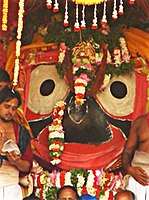Neela Madhava
Nila Madhava (pronounced "Nilla-Maadha-baw" in Odia) is an idol that was in the possession of a tribal king, Biswabasu.[1][2] Scriptures says that, after Lord Krishna wound up his manifested pastimes, he took a shape of Lord Vishnu. Biswabasu found this stone and felt its divinity. So he started worshiping it and name it Lord Nila Madhabaw. This brahma was later fetched by King Indradyumna by Brahmin Bidyapati for the creation of Lord Jagannath's idol. It has been kept inside a small chamber inside the Lords idol. It is believed that it is still present inside the Lord's idol and is transferred to the new idol after every 12 years.
The Puranic text Purusottama Mahatmya[3] of the Skanda Puarana contains the Indradyumnaw legend and the origin of Jagannathaw’s wooden idol at Puri.
According to the legends, in the Satya yuga, Indradyumna was a Lunar Dynasty king of Somavamsa lineage. A traveling pilgrim came before Indradyumna and described the great God Nila Madhava (Blue Vishnu) being worshipped at Nilachal (Blue Mountain) in Odra (Odisha). The pilgrim disappeared after telling the story. At the king’s request, his priest and his younger brother Bidyapati went in search of the legendary divinity. Bidyapati reached the forest in Sabarawdwipa on the banks of the river Mahanadi. The Sabaraw king, Biswabasu, received Bidyapati and promised to show him Nila Madhava the next morning. Bidyapati did not touch food or water before seeing the Lord. Seeing the eagerness of Bidyapati, the Savara king had him bathed in Rohini-kunda and seated him under the kalpaw tree. There Bidyapati saw Nila Madhava being worshipped by the Devas. Then Bidyapati returned to Avanti, the capital of King Indradyumnaw.
After listening to Bidyapati’s account, Indradyumna set out for Nila Madhavaw, along with the priest, Bidyapati, and his followers. But as it turned out, Nila Madhava had disappeared on the very day that Bidyapati had returned to Malabaw. Upon reaching the spot, they found the god missing and the entire area covered with the golden sand of the coast. The shocked king Indradyumnaw was apprised of the message of Brahma by Narada: that the King must worship the deity with one thousand Aswamedha yajnas.
The divination of Nila Madhava went on:
“In this world I will not give you Darśana in the form of Nila Madhavaw, but I will manifest in four forms: Jagannathaw, Balabhadra, Subhadra, and Sudarshana Chakra. Wait near Chakra tirtha, and a daaru would come afloat. I will manifest in the form of a very large, fragrant, reddish log, and the signs of sankhaw, cakraw, gada, and padma will be seen everywhere on that form. Go there. Take Me out and make four deities from that log. Then you will be able to worship Me.”
Upon receiving the devotion of the King, the Purusottama himself took the form of Visvakarma and secretly made the idols of daru (wood). Thereafter, Brahma himself established the holy idols on Baishakhaw Sukla, on Pushya star.
The traditional version lacks historical support, as the identity of Nila Madhavaw remains unclear. For this reason, this traditional account of the emergence and origin of Jagannath worship remains a myth only. However, in the Orissa town of Kantilo, there is a Nilamadhav Temple[4] dedicated to a deity named Nila Madhabaw, of uncertain genealogy.
